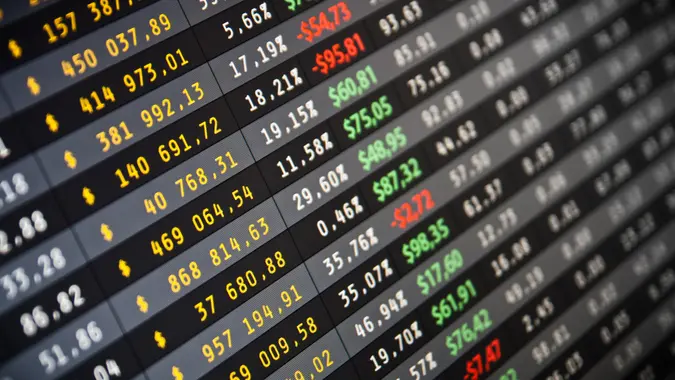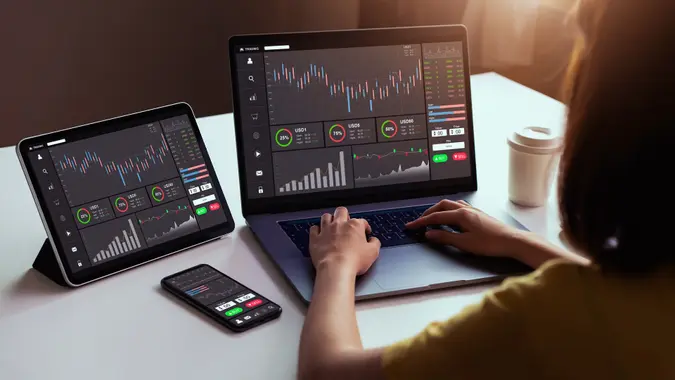Understanding Online Trading Volume

Commitment to Our Readers
GOBankingRates' editorial team is committed to bringing you unbiased reviews and information. We use data-driven methodologies to evaluate financial products and services - our reviews and ratings are not influenced by advertisers. You can read more about our editorial guidelines and our products and services review methodology.

20 Years
Helping You Live Richer

Reviewed
by Experts

Trusted by
Millions of Readers
Trading volume refers to the total number of shares or contracts traded in a given period. It’s used to measure the market’s activity and liquidity during a certain period of time — like a day. It’s an important metric investors and traders use to understand market activity and investor interest.
Here’s a simple example to define the term.
Suppose you have Trader 1 and Trader 2. Trader 1 wants to purchase 200 shares of a particular stock, while Trader 2 wants to sell 200 shares of that same stock. When Trader 1 purchases those shares from Trader 2, the volume of trade would be 200.
Now, say Trader 1 wants to purchase 200 shares of Stock A and sell 100 shares of Stock B. At the same time, Trader 2 wants to sell 200 shares of Stock A and buy 100 shares of Stock B — essentially making the opposite move. The Traders make the exchange with one another. In this example, the total trading volume is 300 (200 shares of Stock A, 100 shares of Stock B).
Trading volume can reveal key information about stocks, investor participation (and conviction) and market activity. For example, if prices and trade volume rise for a particular stock, it could signify greater conviction from investors — and potentially an upward trend. If trade volume falls, it could signify less conviction — and a potential downward price trend.
Types of Volume
When it comes to the stock market, there are two main types of volume: Regular trading volume and unusual or high trading volume.
If a stock moves as intended, it’s considered regular trading volume. This normally means there aren’t major changes to investor conviction or trends regarding that particular stock.
But sometimes trading volume is high or unusual. This occurs when:
- Volume spikes well above the normal range (this may occur shortly before a major price move or indicate a positive change in market sentiment)
- Volume dips below the usual range (this could indicate a sudden lack of interest or the expectation of a downward price trend)
Changes in trade volume can indicate future price movements — either in an upward or downward manner. Note that this isn’t always the case. It’s also possible for the occasional irregular volume spike to indicate something else (like a deal that was negotiated over the course of several weeks).
How to Read Trading Volume
Learning to read trading volume is key for many investors and traders. Here’s an overview of how to analyze volume in charts and how to determine average vs. current volume.
Volume Analysis in Charts
Displaying volume in charts can help traders determine the activity that occurs during a specific trading period. Volume bars in stock charts can indicate both price movements and volume levels — either up-trends or down-trends.
You can generally find changes to volume at the bottom of the stock’s trading chart along with the corresponding time frame for any price moves. Traders may use this information to determine the relationship between price movements and volume levels. For example:
- Increased volume could mean greater buying or selling pressure as company shares change hands.
- Breakout (shares that move beyond typical support or resistance) bars that show increased demand could indicate an upward movement or upcoming new trend.
- If a stock falls below its previous support level, it could indicate trouble for investors (thereby increasing selling pressure) and potentially a higher volume.
Tip: Check the bottom of a stock chart to see changes throughout different days and the volume it closed with on those days. Check for volume spikes (sudden increase in trading volume) and volume divergences (volume moves in one direction while price moves in the other).
Average Volume vs. Current Volume
As defined by Fidelity, the “average volume” is: “The total volume for a specified period divided by the number of bars in that same period.”
You can compare the average volume for a specific period of time to determine if the trading volume is below or above average. To get this metric, add the total volume the stock has had over a specified time — say a week. Divide that by the number of days within that period.
For example, if Stock A had a trading volume of 100 on the first day, 200 on the second, 100 on the third, 400 on the fourth and 200 on the fifth, the sum total would be 1,000. Dividing 1,000 by five (days) gets you 200. This is the average daily trading volume.
Average daily trading volume can reveal a lot about a stock, including stock liquidity and volatility. If prices have increased or decreased while volume has remained relatively high, it could be a sign of a stronger move than if prices fluctuated while volume was low.
Note: Drops in volume can often be seen right after a volume spike.
How to Use Volume Indicators
There are three main ways to use volume indicators in trading:
- Look for volume spikes: High volume during a price increase may confirm a strong trend, while a volume spike during a price drop can signal a potential reversal. A reversal simply means a turnaround of a market trend (e.g., a stock has been trending upward and now starts to trend downward). Volume spikes may indicate buying or selling opportunities. They can even occur when trading volume suddenly drops.
- Compare volume with price movement: A price move with low volume may be unsustainable. High volume with price movement suggests stronger momentum. Momentum investing (betting that the market’s recent winners will continue to perform well) could be worth considering if high volume continues alongside price movement. Low trading volume with rising prices could indicate lower investor conviction.
- Use volume with other indicators: Combine volume analysis with other tools like moving averages or Relative Strength Index (RSI) to get a clearer picture of trends and potential buy/sell signals. The moving average show ongoing updates to the average price over time and can be charted with slopes, increases and decreases to indicate support or resistance levels. RSI assesses the magnitude and speed of recent price changes. It can determine oversold or overbought conditions of the share or security.
Trading Volume and Price Movements
Trading volume and price movements can indicate a lot about the future of a particular stock, but determining whether it’s time to invest — or sell — isn’t always so simple. That said, here’s what high and low volume generally means.
As an aside, trading volume may be higher or lower on specific days or at certain times (such as when the market opens or closes). Mondays and Fridays, for example, may show higher trading volumes, while lunchtime or right before a holiday may show lower volumes.
Does High Volume Mean a Stock Will Go Up?
It’s important to remember that high volume doesn’t guarantee a stock will go up. High volume often indicates strong market participation, which could show support for future price movements. But it does not always mean upward movement.
Bear and bull markets both play a role in this. In a bear market, stock prices decline along with market sentiment. In a bull market, stock prices rise with market sentiment. Price rises on high volume may signify a bullish trend.
Does Low Volume Signal a Decline?
Similarly, low volume doesn’t automatically indicate a significant decline. Low volume doesn’t always mean prices will fall, but it can indicate weaker momentum. It could also be indicative of a bear market.
If prices rise but volume is low, this could signify less overall conviction. Low volume with rising prices may be unsustainable.
Strategies for Using Trading Volume
For traders and investors, it’s important to understand the following:
- Volume breakouts and pullbacks
- How to combine volume with other metrics
Volume in Breakouts and Pullbacks
Investors may use volume to verify breakouts or pullbacks.
High volume can confirm breakouts above resistance levels. Breakouts may occur when a stock moves beyond the normal support or resistance level while having increased volume. A high-volume breakout could indicate continued support and market participation. A low-volume breakout could indicate a lack of conviction.
In a pullback, there’s a temporary decline in stock’s price. This often happens after recent upward momentum. Volume is typically lower than when prices are moving in an upward direction. Lower volume may be indicative of a continual upward trend — which could also be a buying opportunity for traders.
Combining Volume with Other Indicators
Generally speaking, taking a holistic approach to analyzing stock movements is best. Investors can use volume along with other technical indicators — like moving averages or RSI — to confirm trends. Using multiple metrics (including societal, historical and current economic conditions) can also give traders the bigger picture and help them make informed decisions.
Our in-house research team and on-site financial experts work together to create content that’s accurate, impartial, and up to date. We fact-check every single statistic, quote and fact using trusted primary resources to make sure the information we provide is correct. You can learn more about GOBankingRates’ processes and standards in our editorial policy.
- SEC "Bull Market"
- SEC "Bear Market"
- UCLA Anderson "Momentum Investing: It Works, But Why?"
- Fidelity "Average Volume"
- Incredible Charts "Volume Spikes and Dips"
 Written by
Written by  Edited by
Edited by 
























